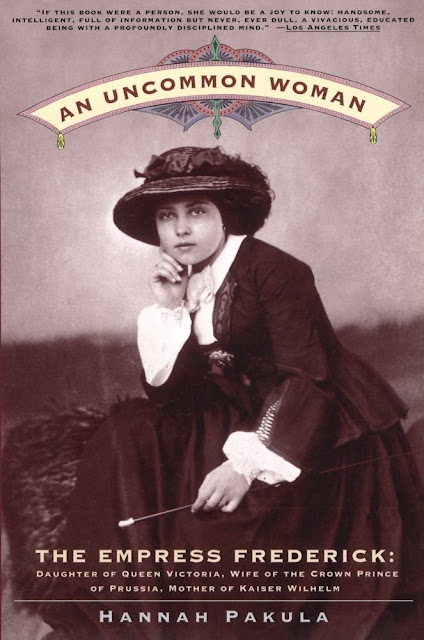
My collage of miniature paintings of Queen Victoria's 9 children from eldest to youngest: Victoria (Vicky), Albert Edward (Bertie), Alice, Alfred (Affie), Helena (Lenchen), Louise (Loosy), Queen Victoria holding Arthur, Leopold (Leo) and Beatrice (Baby). The miniatures of the children were gifts Prince Albert started giving to Queen Victoria.
Many of my readers know I am a history buff. At the moment I'm reading biographies on Queen Victoria's 9 children, one by one. As figures in history and personalities, I like them very much. Yes, they were privileged, but so are we by virtue of living in the 21st century. Overall, the Queen instilled benevolence in her royal children. Each offspring had a strong sense of duty and was devoted to living a life of greater purpose.
 |
| From The Royal Collection here |
Would you like to see a few images of Queen Victoria's children over the years? If yes ... let's begin with a photograph that was taken for the purpose of connecting with the British public (i.e. her subjects):

The family portrait was taken at Osbourne in May, 1857, shortly after the Queen's last child, Princess Beatrice, was born. It is followed by a bulletin of the family after a sad event.
The above collage shows Queen Victoria and her children mourning the death of their husband and father, Prince Albert, who died of what historians now think was Crohn's disease on December 14, 1861.
The 9 siblings as children:

In order of their births: Victoria, the Princess Royal, 1840; Albert Edward, the Prince of Wales, 1841; Princess Alice, 1843; Prince Alfred, 1844; Princess Helena, 1846; Princess Louise, 1848; Prince Arthur, 1850; Prince Leopold, 1853; and Princess Beatrice, 1857.
And later as adults:

Victoria, the Princess Royal became the Crown Princess of Prussia and later German Empress after marrying Crown Prince Frederick; Edward VII of Great Britain reigned from 1901 - 1910. He married Princess Alexandra (Alix) of Denmark; Alice became the Grand Duchess of Hesse and of the Rhine after marrying Prince Louis of Hesse; Alfred became the Duke of Edinburgh, as well as, Duke of Saxe-Colburg-Gotha by inheriting his father's duchy from his (legitimate) childless uncle, Duke Ernst II, who was Prince Albert's older brother. Prince Alfred married Grand Duchess Marie of Russia, Tzar Alexander II's only surviving daughter. Helena took on the title Princess of Schleswig-Holstein after her marriage to Prince Christian of Schleswig-Holstein. Louise became the eventual Duchess of Argyll after marrying aristocrat (and commoner) John Campbell, the Marquis of Lorne and 9th Duke of Argyll; Arthur became the Duke of Connaught and Stratearn. He married Princess Louise Margaret of Prussia; Leopold became the Duke of Albany, as well as, married Princess Helena of Waldeck and Pymount; and youngest child, Beatrice, became a Princess of Battenberg after marrying Prince Henry of Battenberg.
 |
| Another collage of Queen Victoria's adult children from Facebook, which I favor since the person who put it together took time to find flattering photos of them around the same age. Not always easy! |

Wilhelm of Prussia (called Willy and William in the family, later Kaiser Wilhelm II), Charlotte of Prussia (at times called Charley), Henry of Prussia, Victoria of Hesse and of the Rhine (the UK's Prince Phillip's grandmother), Albert Victor of Wales, (called Eddy), Sigismund of Prussia, Elisabeth of Hesse (called Ella), George (later Britain's King George V), Victoria of Prussia, (called Moretta in the family), Irene of Hesse, Louise of Wales, Christian Victor of Schleswig-Holstein (called Christie), Waldemar of Prussia (called Waldie), Victoria of Wales (called Toria), Ernest of Hesse (called Ernie), Albert of Schleswig-Holstein (called Abbie), Maud of Wales (later became the Queen Consort of Norway), Sophie of Prussia (called Sossy, later became the Queen Consort of Greece), Helena Victoria of Schleswig-Holstein (called Thora), Frederick (called Frittie of Hesse), Margaret of Prussia (called Mossy), Alix of Hesse (later became the Empress Alexandra of Russia), Marie-Louise of Schleswig-Holstein, Marie of Hesse (called May), Alfred of Edinburgh and Saxe-Colberg-Gortha (called Young Affie), Marie of Edinburgh and S-C-G (called Missy and later became the Queen Consort of Romania), Victoria Melita of Edinburgh and S-C-G (called Ducky, later became the Grand Duchess of Hesse, then after her 2nd marriage a Grand Duchess of Russia), Alexandra of Edinburgh and S-C-G (called Sandra), Margaret of Connaught (called Daisy, later became the Crown Princess of Sweden), Young Arthur of Connaught, Alice of Albany, Beatrice of Edinburgh and S-C-G (called Baby Bee), Charles Edward of Albany (called Charley, then Karl in German in the wake of inheriting the S-C-G duchy from his Uncle Alfred (after Young Alfred, an only son, died tragically), Patricia of Connaught (called Patsy), Alexander of Battenberg (called Drino and after 1917 Lord Mountbatten by edict of George V), Victoria Eugenie of Battenberg (called Ena, who became the Queen Consort of Spain), Leopold of Battenberg (called Lord Mountbatten after 1917 by edict of George V) and Maurice of Battenberg.
 |
| Affie, Helena and Alice |
You may also enjoy:
Queen Victoria's Family Pictures
Princess Alice Of The United Kingdom
Extra Photos: Prince Leopold, Duke Of Albany
German Empress Victoria: A Book Review And More























































